(完整版)介词加关系代词定语从句
- 格式:docx
- 大小:22.79 KB
- 文档页数:12
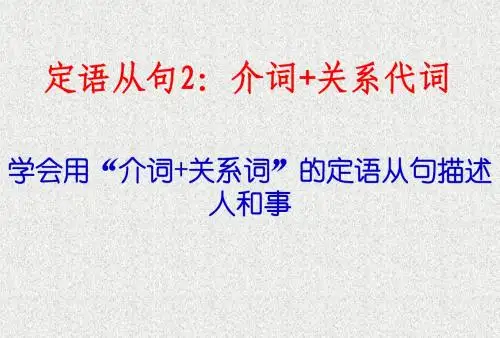
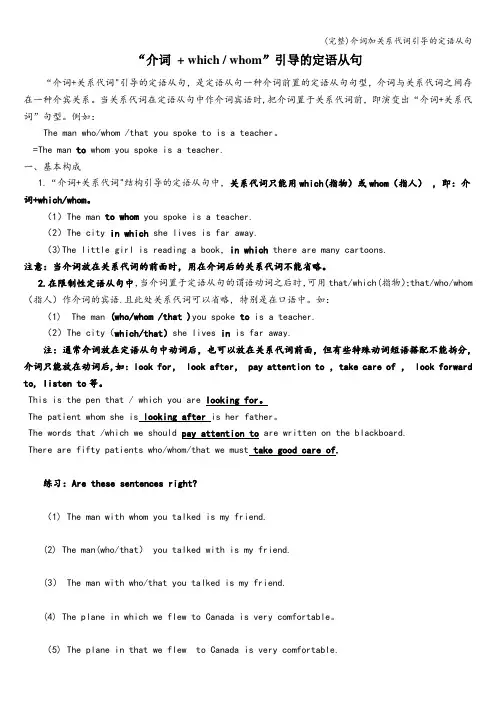
“介词+ which / whom”引导的定语从句“介词+关系代词"引导的定语从句,是定语从句一种介词前置的定语从句句型,介词与关系代词之间存在一种介宾关系。
当关系代词在定语从句中作介词宾语时,把介词置于关系代词前,即演变出“介词+关系代词”句型。
例如:The man who/whom /that you spoke to is a teacher。
=The man to whom you spoke is a teacher.一、基本构成1.“介词+关系代词"结构引导的定语从句中,关系代词只能用which(指物)或whom(指人),即:介词+which/whom。
(1)The man to whom you spoke is a teacher.(2)The city in which she lives is far away.(3)The little girl is reading a book,in which there are many cartoons.注意:当介词放在关系代词的前面时,用在介词后的关系代词不能省略。
2.在限制性定语从句中,当介词置于定语从句的谓语动词之后时,可用that/which(指物);that/who/whom (指人)作介词的宾语.且此处关系代词可以省略,特别是在口语中。
如:(1) The man (who/whom /that )you spoke to is a teacher.(2)The city(which/that)she lives in is far away.注:通常介词放在定语从句中动词后,也可以放在关系代词前面,但有些特殊动词短语搭配不能拆分,介词只能放在动词后,如: look for, look after, pay attention to ,take care of , look forward to, listen to等。
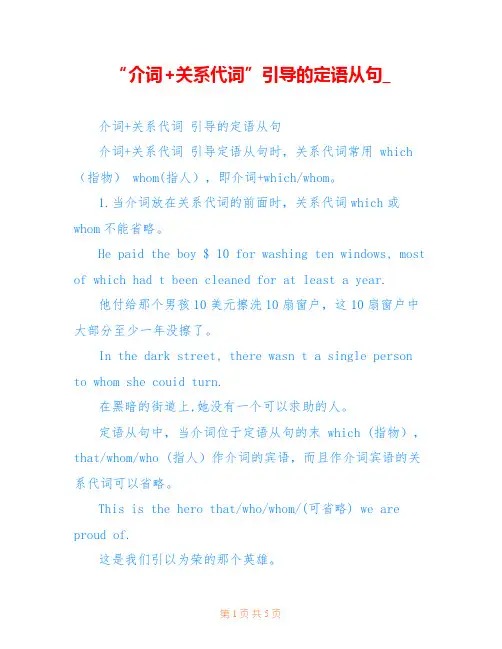
“介词+关系代词”引导的定语从句_介词+关系代词引导的定语从句介词+关系代词引导定语从句时,关系代词常用 which (指物) whom(指人),即介词+which/whom。
1.当介词放在关系代词的前面时,关系代词which或whom不能省略。
He paid the boy $ 10 for washing ten windows, most of which had t been cleaned for at least a year.他付给那个男孩10美元擦洗10扇窗户,这10扇窗户中大部分至少一年没擦了。
In the dark street, there wasn t a single person to whom she couid turn.在黑暗的街道上,她没有一个可以求助的人。
定语从句中,当介词位于定语从句的末 which (指物),that/whom/who (指人)作介词的宾语,而且作介词宾语的关系代词可以省略。
This is the hero that/who/whom/(可省略) we are proud of.这是我们引以为荣的那个英雄。
This is the pen that/which/(可省略) I I wrote the letter with.这是我写信时用的那支钢笔。
【温馨提示】①有些动词+介词的固定词组不可把介词置于关系代词前。
这就是我正在找的磁带。
[误]This is the right tape for which I m looking, [正]This is the right tape that I m looking for.②常见的不可拆开的动词词组有:care for 喜欢,关心deal with 处理,对付get through 通过;到达;接通电话hear from/of 收到某人的来信/听说look for/after寻找/照顾send for派人去请see to照管,料理3.复合介词短语+关系代词which 引导的定语从句,这种结构引导的定语从句常与先行词用逗号分开,定语从句常用倒装语序。
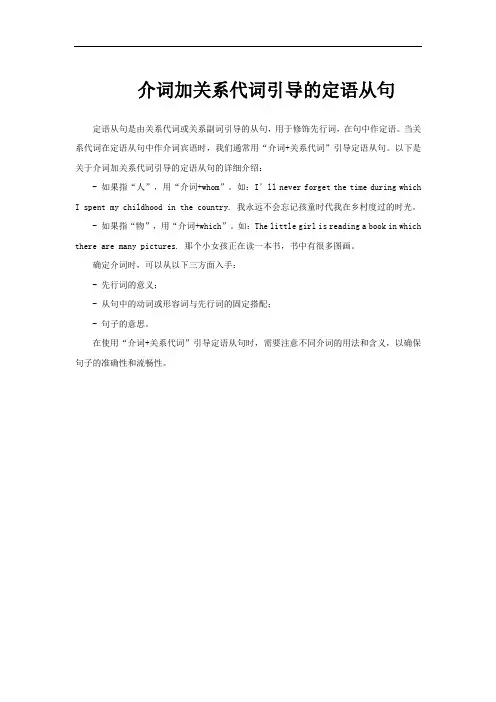
介词加关系代词引导的定语从句
定语从句是由关系代词或关系副词引导的从句,用于修饰先行词,在句中作定语。
当关系代词在定语从句中作介词宾语时,我们通常用“介词+关系代词”引导定语从句。
以下是关于介词加关系代词引导的定语从句的详细介绍:
- 如果指“人”,用“介词+whom”。
如:I’ll never forget the time during which I spent my childhood in the country. 我永远不会忘记孩童时代我在乡村度过的时光。
- 如果指“物”,用“介词+which”。
如:The little girl is reading a book in which there are many pictures. 那个小女孩正在读一本书,书中有很多图画。
确定介词时,可以从以下三方面入手:
- 先行词的意义;
- 从句中的动词或形容词与先行词的固定搭配;
- 句子的意思。
在使用“介词+关系代词”引导定语从句时,需要注意不同介词的用法和含义,以确保句子的准确性和流畅性。

定语从句介词加关系代词用法在定语从句中,介词加关系代词的用法如下:1.关系代词在介词前:当关系代词作为定语从句的主语时,介词通常放在关系代词的前面。
例如:- The man whom I spoke to is my boss.(我与之交谈的那个人是我的老板。
)- The book that I am looking for is on the table.(我要找的那本书在桌子上。
)2.关系代词在介词后:当关系代词作为定语从句的宾语时,介词通常放在关系代词的后面。
例如:- The house which he lives in is very old.(他住在的那栋房子很旧。
)- The car that she is interested in is not available.(她感兴趣的那辆车不可用。
)需要注意的是,当介词后的关系代词是which时,可以省略介词。
例如:- The city which I was born in is famous for its architecture.(我出生的那座城市以其建筑而闻名。
)- The city I was born in is famous for its architecture.(我出生的那座城市以其建筑而闻名。
)同时,也可以通过适当拓展定语从句来提供更多信息:- The man whom I spoke to yesterday, in the cafe near my office, is my boss.(昨天我在我办公室附近的咖啡馆里与之交谈的那个人是我的老板。
)- The book that I am looking for, which is a bestseller,is on the table.(我正在找的那本畅销书就在桌子上。
)。
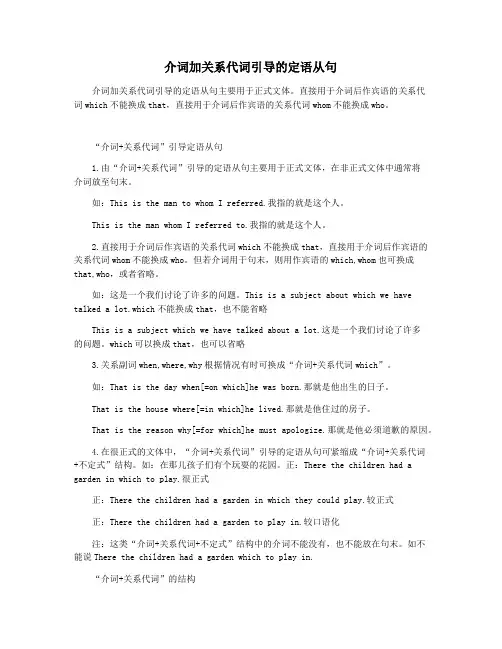
介词加关系代词引导的定语从句介词加关系代词引导的定语从句主要用于正式文体。
直接用于介词后作宾语的关系代词which不能换成that,直接用于介词后作宾语的关系代词whom不能换成who。
“介词+关系代词”引导定语从句1.由“介词+关系代词”引导的定语从句主要用于正式文体,在非正式文体中通常将介词放至句末。
如:This is the man to whom I referred.我指的就是这个人。
This is the man whom I referred to.我指的就是这个人。
2.直接用于介词后作宾语的关系代词which不能换成that,直接用于介词后作宾语的关系代词whom不能换成who。
但若介词用于句末,则用作宾语的which,whom也可换成that,who,或者省略。
如:这是一个我们讨论了许多的问题。
This is a subject about which we have talked a lot.which不能换成that,也不能省略This is a subject which we have talked about a lot.这是一个我们讨论了许多的问题。
which可以换成that,也可以省略3.关系副词when,where,why根据情况有时可换成“介词+关系代词which”。
如:That is the day when[=on which]he was born.那就是他出生的日子。
That is the house where[=in which]he lived.那就是他住过的房子。
That is the reason why[=for which]he must apologize.那就是他必须道歉的原因。
4.在很正式的文体中,“介词+关系代词”引导的定语从句可紧缩成“介词+关系代词+不定式”结构。
如:在那儿孩子们有个玩耍的花园。
正:There the children had a garden in which to play.很正式正:There the children had a garden in which they could play.较正式正:There the children had a garden to play in.较口语化注:这类“介词+关系代词+不定式”结构中的介词不能没有,也不能放在句末。
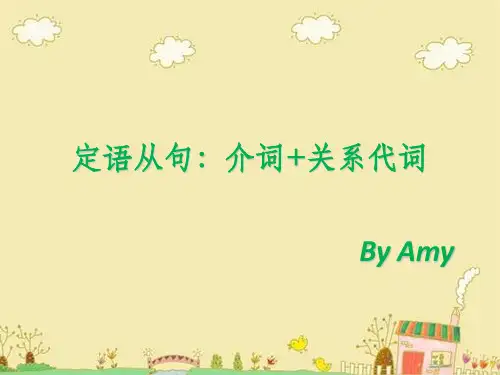
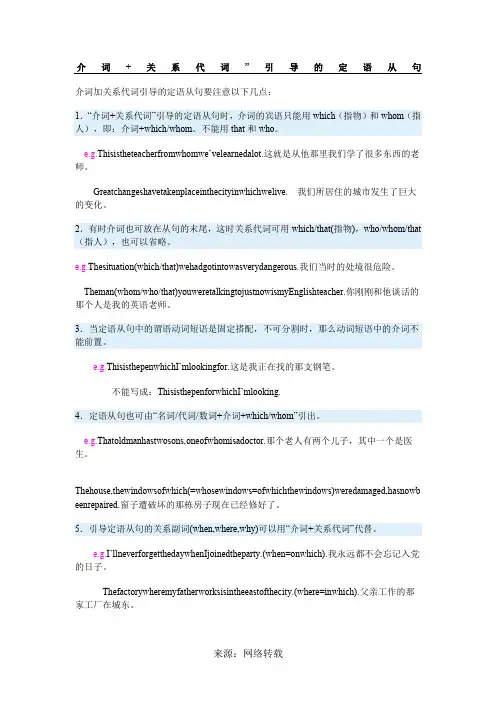
介词+关系代词”引导的定语从句
介词加关系代词引导的定语从句要注意以下几点:
1.“介词+关系代词”引导的定语从句时,介词的宾语只能用which(指物)和whom(指人),即:介词+which/whom。
不能用that和who。
e.g.Thisistheteacherfromwhomwe’velearnedalot.这就是从他那里我们学了很多东西的老师。
5.引导定语从句的关系副词(when,where,why)可以用“介词+关系代词”代替。
e.g.I’llneverforgetthedaywhenIjoinedtheparty.(when=onwhich).我永远都不会忘记入党的日子。
Thefactorywheremyfatherworksisintheeastofthecity.(where=inwhich).父亲工作的那家工厂在城东。
来源:网络转载
NoneofusknowthereasonwhyTomwasabsentfromthemeeting.(why=forwhich).我们都不知道汤姆缺席会议的原因。
6.“复合介词短语+which”引导的定语从句,常与先行词用逗号隔开,而且定语从句常用倒装语序。
e.g.Helivedinabighouse,infrontofwhichstoodabigtalltree.他住在一幢大房子里,房前有一棵大树。
来源:网络转载。
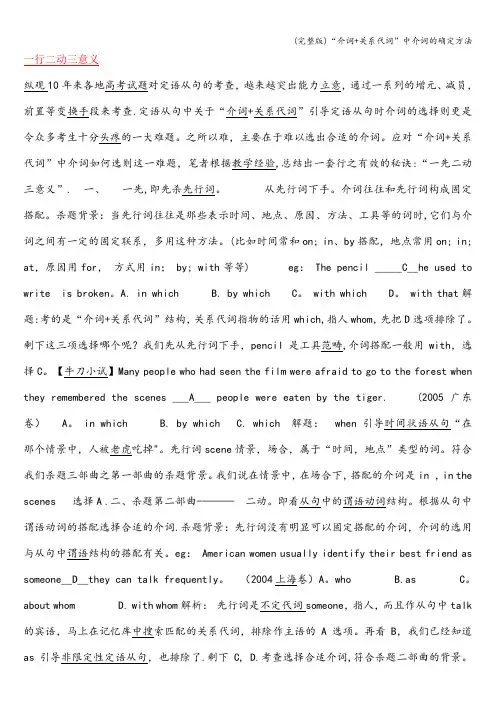
一行二动三意义纵观10年来各地高考试题对定语从句的考查,越来越突出能力立意,通过一系列的增元、减员,前置等变换手段来考查.定语从句中关于“介词+关系代词”引导定语从句时介词的选择则更是令众多考生十分头疼的一大难题。
之所以难,主要在于难以选出合适的介词。
应对“介词+关系代词”中介词如何选则这一难题,笔者根据教学经验,总结出一套行之有效的秘诀:“一先二动三意义”.一、一先,即先杀先行词。
从先行词下手。
介词往往和先行词构成固定搭配。
杀题背景:当先行词往往是那些表示时间、地点、原因、方法、工具等的词时,它们与介词之间有一定的固定联系,多用这种方法。
(比如时间常和on; in、by搭配,地点常用on; in; at,原因用for,方式用in; by; with等等) eg: The pencil _____C__he used to write is broken。
A. in which B. by which C。
with which D。
with that解题:考的是“介词+关系代词”结构,关系代词指物的话用which,指人whom,先把D选项排除了。
剩下这三项选择哪个呢?我们先从先行词下手,pencil是工具范畴,介词搭配一般用with,选择C。
【牛刀小试】Many people who had seen the film were afraid to go to the forest when they remembered the scenes ___A___ people were eaten by the tiger. (2005广东卷) A。
in which B. by which C. which 解题:when 引导时间状语从句“在那个情景中,人被老虎吃掉"。
先行词scene情景,场合,属于“时间,地点”类型的词。
符合我们杀题三部曲之第一部曲的杀题背景。
我们说在情景中,在场合下,搭配的介词是in ,in the scenes 选择A .二、杀题第二部曲-———二动。
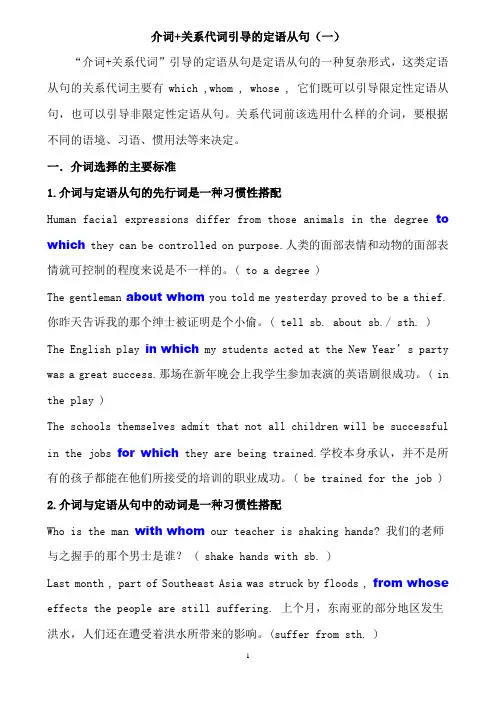
介词+关系代词引导的定语从句(一)“介词+关系代词”引导的定语从句是定语从句的一种复杂形式,这类定语从句的关系代词主要有which ,whom , whose , 它们既可以引导限定性定语从句,也可以引导非限定性定语从句。
关系代词前该选用什么样的介词,要根据不同的语境、习语、惯用法等来决定。
一.介词选择的主要标准1.介词与定语从句的先行词是一种习惯性搭配Human facial expressions differ from those animals in the degree to which they can be controlled on purpose.人类的面部表情和动物的面部表情就可控制的程度来说是不一样的。
( to a degree )The gentleman about whom you told me yesterday proved to be a thief.你昨天告诉我的那个绅士被证明是个小偷。
( tell sb. about sb./ sth. ) The English play in which my students acted at the New Year’s party was a great success.那场在新年晚会上我学生参加表演的英语剧很成功。
( in the play )The schools themselves admit that not all children will be successful in the jobs for which they are being trained.学校本身承认,并不是所有的孩子都能在他们所接受的培训的职业成功。
( be trained for the job ) 2.介词与定语从句中的动词是一种习惯性搭配Who is the man with whom our teacher is shaking hands? 我们的老师与之握手的那个男士是谁? ( shake hands with sb. )Last month , part of Southeast Asia was struck by floods , from whose effects the people are still suffering. 上个月,东南亚的部分地区发生洪水,人们还在遭受着洪水所带来的影响。
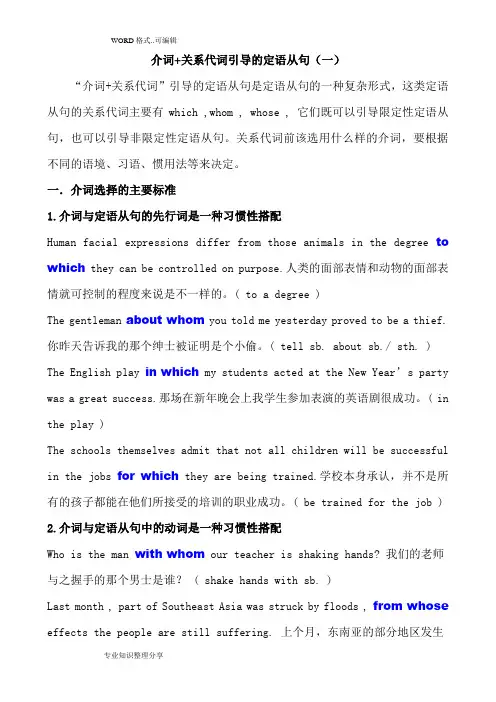
介词+关系代词引导的定语从句(一)“介词+关系代词”引导的定语从句是定语从句的一种复杂形式,这类定语从句的关系代词主要有which ,whom , whose , 它们既可以引导限定性定语从句,也可以引导非限定性定语从句。
关系代词前该选用什么样的介词,要根据不同的语境、习语、惯用法等来决定。
一.介词选择的主要标准1.介词与定语从句的先行词是一种习惯性搭配Human facial expressions differ from those animals in the degree to which they can be controlled on purpose.人类的面部表情和动物的面部表情就可控制的程度来说是不一样的。
( to a degree )The gentleman about whom you told me yesterday proved to be a thief.你昨天告诉我的那个绅士被证明是个小偷。
( tell sb. about sb./ sth. ) The English play in which my students acted at the New Year’s party was a great success.那场在新年晚会上我学生参加表演的英语剧很成功。
( in the play )The schools themselves admit that not all children will be successful in the jobs for which they are being trained.学校本身承认,并不是所有的孩子都能在他们所接受的培训的职业成功。
( be trained for the job ) 2.介词与定语从句中的动词是一种习惯性搭配Who is the man with whom our teacher is shaking hands? 我们的老师与之握手的那个男士是谁? ( shake hands with sb. )Last month , part of Southeast Asia was struck by floods , from whose effects the people are still suffering. 上个月,东南亚的部分地区发生洪水,人们还在遭受着洪水所带来的影响。
语法由介词+关系代词引导的定语从句1. 介词+关系代词中介词的位置关系代词whom,which,whose在从句中作介词宾语时,可以跟介词一起放在从句与主句之间(that,who不可以),也可以把介词放在从句中有关动词的后面,使关系代词紧跟它所修饰的先行词。
例如:He is a man of rich experience, from whom much can be learned.=He is a man of rich experience, whom much can be learned from.他是个经验丰富的人,从他那里能学到很多。
The school in which he once worked is a key school.=The school (which/that) he once worked in is a key school.他曾经工作过的学校是一所重点学校。
The manager in whose company I work pays much attention to improving our working conditions.=The manager whose company I'm working in pays much attention to improving our working conditions.我就职的那家公司的经理十分注意改善我们的工作条件。
2. 介词+关系代词的常见结构(1) 介词+which/whom例如:This is the famous singer about whom we have often talked.这就是那位我们经常谈论的著名歌唱家。
Fortunately we had a map, without which we would have got lost.很幸运,我们带了一张地图,如果没有的话,我们就会迷路了。
1.“哇塞,‘The book on which I spent a lot of time is really interesting.’就像找到了一个宝藏。
比如说我读那本书的时候,可不就像在挖掘宝藏嘛。
”(例子:读那书如挖宝藏,如超棒“这句超棒” 棒。
)2.“嘿,‘The person with whom I had a great conversation is so smart.’有次和那个人聊天,那感觉就像和智者对话。
这也太厉害了吧。
”(例子:和那人聊如和智者对话,如厉害“这句好厉害” 厉。
)3.“哎呀,‘The place in which I had a wonderful time is like a paradise.’咱就像进入了一个梦幻之地。
比如我在那个地方玩的时候,多让人开心。
”(例子:在那玩如进梦幻地,如开心“这句好开心” 心。
)4.“哇哦,‘The movie about which we talked a lot is really moving.’这不是很让人感动嘛!有次我们讨论那部电影,就像在分享一个感人的故事。
”(例子:论电影如分享感人故事,如感动“这句好感动” 动。
)5.“嘿,‘The song to which I always listen is like a magic spell.’有那么一种神奇的感觉。
就像被施了魔法。
比如我听那首歌的时候,那叫一个陶醉。
”(例子:听那歌如被施魔法,如陶醉“这句好陶醉” 醉。
)6.“哎呀,‘The game in which I participated is so exciting.’咱就像参加了一场冒险。
比如我玩那个游戏的时候,多让人兴奋。
”(例子:玩游戏如参加冒险,如兴奋“这句好兴奋” 奋。
)7.“哇,‘The person for whom I did a favor is very grateful.’有次我帮那个人,就像做了一件好事。
(完整版)介词加关系代词定语从句“介词+关系代词”引导的定语从句“介词+关系代词”型定语从句五大考点“介词+关系代词”引导的定语从句是英语语法中的难点和重点,近年来高考对这一语法结构的考查大有升温之势。
在介词后作宾语的关系代词只有which和whom。
如先行词是物,引导词用which;如先行词是人,则引导词用whom。
如:This is the ship by which I went to Shanghai.This is the student for whom I bought the book.考点1简单介词+关系代词知识归纳:用于此结构的关系代词指人时只能用whom,指物时只能用which;介词选择的依据主要是根据从句中的动词、形容词、名词与介词的不变搭配而定;或者以先行词与从句中的动词关系及所表达的含义而定;或者以先行词在定语从句中的作用和含义而定,并且含有介词的短语动词不能拆开,介词仍然放在动词之后。
(1)根据定语从句中的谓语动词确定介词,其动词或介词搭配,构成动词短语。
例如:Is this the carfor whichyou paid a high price? (pay for)In the dark street, there wasn’t a single personto whomshe could turn for help. (turn to sb forhelp)The manwith whomyou shook hands just now is our English teacher. (shake hands with sb)(2)根据定语从句中的形容词确定介词,其形容词与介词搭配,构成形容词短语。
例如:The two thingsabout whichKarl Marx was not sure were the grammar and some of the idioms.(be sure about)The teacherof whomthe students in our class are fond is Mr Wang, our English teacher. (be fondof)(3)根据定语从句所修饰的先行词确定介词,其先行词往往是表示时间、地点、原因、方法、工具等的词,它们与介词之间有一定的联系。
当“介词+关系代词”在定语从句中充任时间、地点、原因状语时,可分别用when, where, why替换。
例如:I”ll never forget the dayon which(=when) I joined the army.The factoryin which(=where) his father works is far away from my hometown.I don”t know the reason f or which (=why) he was late.(4)根据句子的意思确定介词。
有些句子,先行词完全一样,定语从句中谓语动词不是由不变的动词短语构成的,这时,要根据句子所要表达的意思,选用例外的介词。
例如:This is the pilotfor whomI bought a camera.This is the pilotwith whommy brother has worked for ten years.This is the pilotby whommy son was saved.1.(2004全国卷)Thejourneyaroundtheworldtooktheoldsailorninemonths,_ ______thesailing time was 226 days.A. of whichB. during whichC. from whichD. for which解析:关系代词which指代the journey,定语从句恢复为独立的句子是:The sailing time of thejourney was 226 days.故答案选A。
2. (2004全国卷) T he English play _______ my students acted at the New Year“s party was a greatsuccess.A. for whichB. at whichC. in whichD. on which解析:本句主句部分应是The English play at the New Year“s party was a great success.从句补全为独立的句子是:My studentsacted in the play.故答案选C。
3. (2004上海卷) American women usually identify their best friend as someone _______ they cantalk frequently.A. whoB. asC. about whichD. with whom解析:先行词为someone,被关系代词whom代替在从句中作talk with的宾语,介词with可以放在关系代词之前,identify...as...意为“把……当作……”,故答案选D。
考点2繁复介词+关系代词知识归纳:用于此结构的关系代词有which,whom,whose。
常用于该结构的繁复介词有:asaresultof,atthebackof,becauseof,bymeansof,forwantof,infro ntof,incaseof,onaccou nt of等。
例如:We got to a house at the back of which was a large garden.Is there a certain test by means of which the No. 1 will be decided?考点3简单介词+关系代词+名词知识归纳:用于此结构的关系代词有which, whose。
介词的选择取决于关系代词后的名词及整个句子的含义。
高考考例:(1995上海)Intheoffice,Ineverseemtohavetimeuntilafter5:30p.m.______ _timemanypeople have gone home.A. whoseB. thatC. on whichD. by which解析:介词by表示时间的意思是“到那时为止”。
这句话的意思是“在办公室里,我似乎直到下午5:30才有空,那时许多人都已经回家了”。
故答案选D。
考点4the+名词+of+关系代词知识归纳:用于此结构的关系代词只有which。
该结构表示所有关系,口语中常用“whose +名词”代替。
非正式文体中可以用“of which the +名词”。
高考考例:(2000上海) Recently I bought an ancient Chinese vase, _______ was very reasonable.A. which priceB. the price of whichC. its priceD. the price of whose解析:答案选B。
本题就是一个考查the+名词+of+关系代词结构的一个典型例子。
这里theprice of which指代the price of the vase,答案也可以是whose price。
考点5表示部分的词语+of+关系代词知识归纳:此时,指人的关系代词只能是whom,指物的关系代词只能是which。
表示部分的词语多见的有:不定代词all, both, none, neither, either, some, any,数词(含基数词,序数词,分数和百分数);数词+名词;the+最高级/比较级,以及表示数目或数量的词语many, most, few,several, enough, half a, a quarter。
高考考例:1. (2004湖北卷) There are two buildings, ________ stands nearly a hundred feet high.A. the largerB. the larger of themC. the larger one thatD. the larger of which 解析:答案为D。
the larger of which指代the larger of the two buildings; B选项缺少一个连词。
2. (2004辽宁卷) The factory produces half a million pairs of shoes every year, 80% _______ aresold abroad.A. of whichB. which ofC. of themD. of that解析:答案为A。
80% of which指代的是80% of the shoes。
本题意为:这家工厂每年生产的50万双鞋子有80%都是销往国外的。
“介词关系代词”引导的定语从句多见错误我们在学习定语从句时,常常会看到“介词+关系代词“引导的定语从句,即把从句中的某一介词或介词短语提到关系代词前.使用这类定语从句时,常常会出现五类错误.现在归纳如下:一、关系词的误用1. The person to who you should write is Mr Hall. (whom)2. I lost the book in that there are five color pictures. (which)3. The day on when we can send men into space has at last come. (which)4. He went back to the house in where he was born twenty years ago. (which)简析:当介词位于从句的句首时,介词后大凡用关系代词whom(指人,如1不可为who所代替)或which(指物,如2.先行词即使为表示时间或地点的名词,介词后也不能用when或where,如3和4).不过,注意介词from有时根据句意的需要,也可以接where.如:He hid himself behind the door, from where he saw the man take a photo of something on thedesk.他躲在门后面,从那里他看见那个人拍摄了桌子上的什么东西一下.(指frombehindthedoor“从门后面“,并非指from the door“从门“)二、拆开从句中极不变的动词搭配5. He was the boy after whom the woman had looked for many years. (whom the woman hadlooked after for many years) 简析:若将定语从句中搭配极为不变的短语中的介词提前,其中的短语可能会失去它们本身的意义或可能使句子产生歧义,如look after, look for, depend on, go in for (迷恋)等短语.三、介词与定语从句所修饰的先行词搭配不当6. The farm in which we worked ten ye ars ago isn“t what it used to be. (on)7. She wanted to find the way with which she could make everyone live more happily. (in)简析:6. on the farm为习惯搭配,表示“在农场“;7. in与way搭配,表示“用……办法,以……方式“.四、介词与定语从句中的谓语部分搭配不当8. In the dark street, there wasn“t a single pers on from whom she could turn for help. (to)9. This is the tree in which the boat was tied. (to)10. Can you find an object with which your toy is similar? (to)简析:8.turntosb.forhelp表示“向某人求助“;9.tie与to连用,表示“拴/系到……上“;10.similar与to搭配,表示“与……相似“.五、介词与句子的详尽含义搭配不当11. I can“t remember the age in which I won that prize. (at)12. That is the age at which people live in peace and happy. (in)简析:根据全句意义,11中的age作“年岁“解,应与at搭配;12中的age表示“时期,时代“,应与in搭配.练习:用合适的“介词+关系代词”填空。